Kungliga Slottet, the Royal Palace of Stockholm, is one of Northern Europe’s most magnificent palaces. Every day during summer crowds gather at the palace’s outer courtyard to witness the change of the guards.


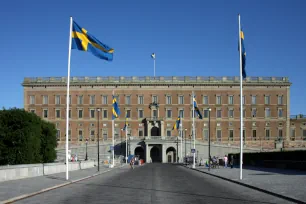
Even though Drottningholm Palace is now the official residence of the royal family, the Royal Palace is still used for official banquets and meetings with foreign dignitaries.
The Tre Kronor Castle
A defensive stronghold with a watchtower stood at this site as early as in the tenth or eleventh century. Under the rule of Birger Jarl, legendary founder of Stockholm, the structure evolved into a castle in the thirteenth century.
During the sixteenth century, when a large tower was built, it became known as the Tre Kronor castle, named after three golden crowns that decorated the tower. In the following decades, during the reign of John III, the castle was converted into a royal Renaissance style residence.
The castle was remodeled again in the mid-seventeenth century, with the reconstruction of the north wing to a Baroque design by Nicodemus Tessin the Younger. This wing was the only part standing after a fire in 1697 reduced much of the castle to rubble.
The Present Palace
Soon after the destruction of the Tre Kronor Castle, Nicodemus Tessin the Younger started drawing up plans for a new palace, and that same year the restoration of the north wing started while the rubble of the burnt down castle was cleared.
But shortly after the construction of the new Royal Palace had started, the Great Northern War broke out and by 1707 the cost of the war had taken such a toll on the royal finances that construction of the new palace was halted.

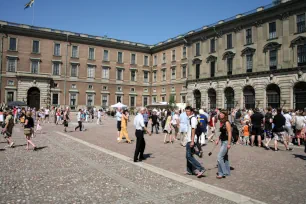
Work only resumed in 1727, one year before the death of Nicodemus Tessin the Younger. He was succeeded by Carl Hårleman, who carried out Tessin’s plans for the exterior, and built the interior in the new Rococo style. The palace was finally completed in 1754, and Adolf Frederick was the first king to move in.
Exterior
Nicodemus Tessin the Younger built the Royal Palace around a rectangular courtyard. The exterior was designed in a Baroque style with High Renaissance elements.
On the east side is a small, terraced garden: the Logården; the west side is entered via an outer courtyard surrounded by a semicircular colonnade. This is where the daily ceremony for the Change of the Guards takes place.
The south facade, bordering Slottsbacken, has a monumental entrance gate decorated with colossal Corinthian columns and large statues set in niches. The north facade is still the original from the seventeenth century; its design was inspired by the Farnese Palace in Rome.
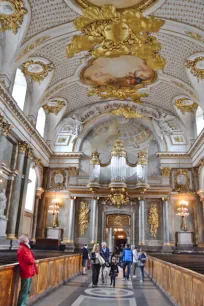
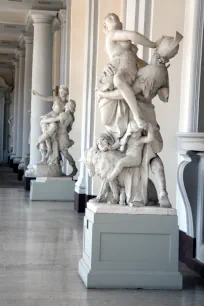
Interior

Many of the more than six hundred rooms are open to the public, including the royal apartments, which can be accessed via the entrance at the outer courtyard.
These luxuriously decorated rooms are used for official receptions and dinners, which often take place in the Gallery of Charles XI, a magnificent room modeled after the mirror room at the Versailles Palace.
Next are the guest apartments, used by official guests of the royal family. One floor below are the fourteen Bernadotte rooms.
Here you’ll find the Pillared Hall, one of the most beautiful rooms in the palace, with a magnificent Rococo interior decorated with twelve Ionic columns. The Bernadotte Library contains the royal book collection and the Bernadotte Gallery is decorated with portraits of the rulers of the Bernadotte Dynasty, the current royal house of Sweden.
Downstairs is one of the most famous rooms in the palace, the Rikssalen (State Room). Its silver throne, created in 1650 for the coronation of Queen Christina, is one of few items that were saved from the disastrous fire of 1697. Another highlight of the palace is the magnificent Royal Chapel, consecrated in 1754 and decorated by Carl Hårleman in Rococo style.
Museums
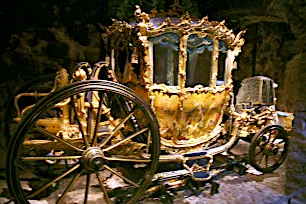

There are several museums in the palace: the Tre Kronor Museum at the north side of the palace illustrates the medieval history of the palace with a display of objects that were recovered from the ruins of the castle.
King Gustav III brought a number of statues from Rome, these are displayed in the Gustav III Antikmuseum, which occupies a floor of the palace’s northeast wing.
The Livrustkammaren (Royal armory) at Slottsbacken has a collection of royal armor, carriages and historic costumes.
The Skattkammaren (Treasure chamber), at the south side of the palace, shows the royal crown jewels and other treasures such as the sword of King Gustav Vasa.
The Royal Guards
The Royal Guards, selected from military units across Sweden, are a popular attraction in Stockholm. They have been guarding the palace since 1523.
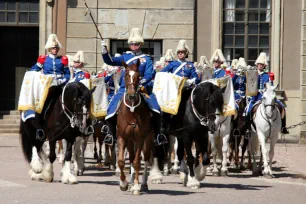
During summer months, large crowds gather at the outer courtyard on the west side of the palace, where they witness the daily spectacle of the changing of the guards. It is especially interesting during the summer months, when the mounted band of the royal guards take part in the ceremony. The mounted guards start from the Cavalry Barracks, while the marching guards start from the Army Museum. They arrive at the palace around 12:15; around 13:15 on Sundays and public holidays. The ceremony lasts about forty minutes.
- Next: Vasa Museum
- More Sights & Attractions in Stockholm

